H. P. Lovecraft: The Science of Horror – Part 1
In Part 1 of a two-part essay, I examine the American writer of “weird fiction,” H. P. Lovecraft, on the 100th anniversary of World War I. Here I give an overview of Lovecraft’s writings, examine his growing popularity in American culture over the last thirty years in a variety of media forms, and explain the main reasons for this popularity.
Lovecraft and the Dark Heart of the Modern World
One hundred years ago – in August of 1914 – the German army invaded Belgium with the aim of quickly entering and subduing France. This incursion by the Germans marks the beginning of an unprecedented mechanized cataclysm that would shock and engulf the world. The incident that set into motion the series of events which led to world war occurred on the 28th of June, when a 19-year-old Yugoslav nationalist, Gavrilo Princip, shot and killed the heir to the Hapsburg throne of the Austria-Hungarian Empire, Archduke Franz Ferdinand, as well as his wife, the Duchess Sophie. This double murder sparked actions and reactions which would ultimately lead to war.
What perplexed those at the time, and in hindsight, concerns the events which led to war: they were seemingly neither necessary nor inevitable. The chain of events were, bluntly, irrational. As the historian of war John Keegan notes: “The train of events that led to its outbreak might have been broken at any point during the five weeks of crisis that preceded the first clash of arms” (Keegan, 1998). As the combatants would learn over the next four years, at the heart of a supposedly enlightened Europe there dwelt in the shadows a potent irrationality that would destroy a good proportion of a generation of young men in the states of England, France, and Germany. The war would also mutilate any sort of optimistic view that European nations could solve their problems diplomatically and without recourse to arms. That notion, given concrete actuality with the short-lived League of Nations immediately after the war, would come to be seen as risible and of absolutely no use in mediating conflicts between the great powers. (In fact, the United States did not join the League of Nations – the U. S. Senate refused to support it.)
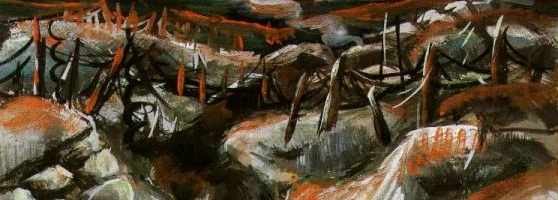
Oswald Spengler (more on this author and his influence on Lovecraft in Part 2 of this essay), a German scholar, mocked the notion of a world without war, considering such a picture an entirely unrealistic and false picture of man, his relations to other men, and the relationship between nations or states. As Spengler characterizes it, the quest for an eternal peace between nation-states would end in a sort of entropic heat death:
“No more war; no more distinction of law, peoples, states, or religions; no criminals or adventurers; no conflicts arising out superiorities and unlikenesses, no more hate or vengeance, but just an unending comfort through all millennia. Even today, when we are still living out the last phases of this trivial optimism, these imbecilities make one shudder, thinking of the appalling boredom – the taedium vitae of the Roman Imperial age – that spreads over the soul in the mere reading of such idylls, of which even a partial actualization in real life could only lead to wholesale murder and suicide” (Spengler, 1931, pp. 7-8).
During the time of the war, through the roaring twenties, and then the moribund years of the great world depression, an idiosyncratic, maladjusted, and disturbing writer, living in Providence, Rhode Island, created in a series of short stories and novellas a Weltanschauung of terror and hopelessness. His fictive corpus dramatized his perception of the barbarous World War and of various pernicious trends at work in the modern world. These perceived trends include the mechanization, industrialization, and urbanization of society, perceived as the product of scientific and technologic progress, and the capitalist degradation of aesthetic and intellectual judgment.
As for WWI, he was as pessimistic as Spengler about idealized and impractical attempts to prevent war. In a short article entitled At the Root, written at the end of the war, he wrote:
“…we must learn to discard forever the sentimental standpoint, and to view our species through the cold eye of science alone. We must recognise the essential underlying savagery in the animal called man, and return to older and sounder principles of national life and defence. We must realize that man’s nature will remain the same so long as he remains man; that civilisation is but a slight coverlet beneath which the dominant beast sleeps lightly and every ready to awake” (Lovecraft, 1918).
Howard Philips Lovecraft – HPL hereafter – little known in his time, produced a body of work which has, over the course of the 77 years after his death, become a surprisingly popular and resonant influence in American popular culture. Writers such as Joyce Carol Oates, Stephen King, Michael Chabon, Alan Moore, Poppy Z. Brite, Joe R. Lansdale, Neil Gaiman, and China Miéville have all acknowledged Lovecraft’s influence on their own writings, and have praised his fiction, going so far as to say, in Stephen King’s words, that “Now that time has given us some perspective on his work, I think it is beyond doubt that H. P. Lovecraft has yet to be surpassed as the twentieth century’s greatest practitioner of the classic horror tale” (King, 1995).
The film-maker and artist Guillermo del Toro, the editor of the new Penguin Horror series, writes in his introduction to the volume of stories by HPL (The Thing on the Doorstep and Other Weird Tales), that HPL “is a well-versed student of the weird tale and can metamorphose at will. He drinks from the wells of Poe, William Hope Hodgson, Algernon Blackwood, Lord Dunsany, Arthur Machen, and many others, but impresses all of his narratives with his own phobic, misanthropic seal. No one has ever created a more adverse and bizarre cosmos than Lovecraft. No one” (Toro, 2001, p. xx).
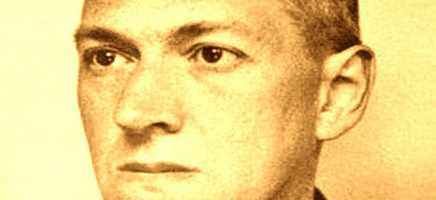
Posterity has vouchsafed to HPL the recognition that eluded him in his lifetime. Perhaps the (ironic) apotheosis of the atheist HPL occurred in 2005, when the prim Library of America issued H. P. Lovecraft: Tales, selected and edited by Peter Straub. Lovecraft henceforth becomes an acknowledged master of the weird tale, a virtuoso of “cosmic horror,” a writer who consistently gave voice to certain philosophical concepts and a world view that he had developed during the course of his studies. Lovecraft was an autodidact; he attended school sporadically, never went to college, and studiously read material on a wide range of topics, from astronomy and Einstein’s theory of relativity and quantum physics, to current thought on biology and the evolution of man, to the then controversial geologic theory of plate tectonics.
In Lovecraft’s own assessment of his fiction, he attempted to create what he called “cosmic horror.” In an age of ever-increasing scientific knowledge, the old bugbears of gothic horror fiction – enfeebled vampires, hoary werewolves, worn out insubstantial ghosts or other decrepit supernatural entities – seem, and are, ludicrous. What isalarming and repellant is reality itself. In his long and much praised essay Supernatural Horror in Literature, he puts it this way:
“Children will always be afraid of the dark, and men with minds sensitive to hereditary impulse will always tremble at the thought of the hidden and fathomless worlds of strange life which may pulsate in the gulfs beyond the stars, or press hideously upon our own globe in unholy dimensions which only the dead and the moonstruck can glimpse. With this foundation, no one need wonder at the existence of a literature of cosmic fear. It has always existed, and always will exist…” (Lovecraft, 1927).
Therefore his aim was to create…
“A certain atmosphere of breathless and unexplainable dread of outer, unknown forces must be present; and there must be a hint, expressed with a seriousness and portentousness becoming its subject, of that most terrible conception of the human brain – a malign and particular suspension or defeat of those fixed laws of Nature which are our only safeguard against the assaults of chaos and the daemons of unplumbed space…The one test of the really weird is simply this – whether or not there be excited in the reader a profound sense of dread, and of contact with unknown spheres and powers; a subtle attitude of awed listening, as if for the beating of black wings or the scratching of outside shapes and entities on the known universe’s utmost rim” (Lovecraft, 1927).
Given the burgeoning interest of all things Lovecraftian, questions arise, proliferating like the numerous alarming alien beings found in his fiction. These questions concern both Lovecraft’s popularity and the more philosophical questions about the nature of science and scientific knowledge; his view that the human race is insignificant in the grand scheme of things; reality as conceived on a scientific basis is itself a source of terror; and the bleak claim of the inextricable relationship between science and an ever-increasing decadence of Western culture. Before addressing the philosophic questions raised by Lovecraft in his fiction, a review of the omnipresent cult of Lovecraft is in order, as it will give us an idea as to just how entrenched Lovecraft’s creations and mythic world have become in American popular culture.
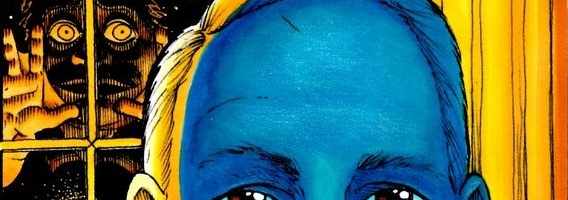
Lovecraft and Popular Culture
Lovecraft, in a life cut short by intestinal cancer (born in 1890, died in 1937), wrote some 60 short stories, novellas, and poetry. In addition to these works of fiction, HPL wrote a staggering number of letters to young authors, readers of his stories, and questioning fans. The science fiction writer L. Sprague de Camp wrote a biography of Lovecraft in 1975 and estimated that Lovecraft wrote 100,000 letters in his lifetime, a fifth of which are believed to survive. Many of these letters range from 10 to 50 pages long. Lovecraft cultivated epistolary relationships with aspiring authors, and encouraged them to use his creations in their own work, whether creatures, fictitious books, characters, or institutions (i.e. Miskatonic University, Cthulhu and other creatures, the sunken city of R’lyeh, the ersatz book The Necronomicon). In effect, HPL ensured that a generation of writers would carry on, with more or less success, his efforts in producing the dread of cosmic horror. The most well-known of these young authors include Robert Bloch (Psycho); Robert E. Howard, creator of Conan the Barbarian; Clark Ashton Smith; Fritz Leiber; and August Derleth.
Lovecraft’s fiction was almost exclusively published in the pulp magazine Weird Tales – a pulp magazine first published in 1923 (it ceased its original run in 1954, with a total of 279 issues). This in part explains why Lovecraft was never taken seriously as an author during his lifetime. The pulps were considered “low” art, insignificant as literature, of no artistic weight despite the fact that Weird Tales was, in terms of the quality of its stories, a notch above the thousands of other pulps. “As an alternative to the commercially popular yet raunchy and poorly written ‘shudder pulps,’ the editors, writers and readers of Weird Tales were determined to distinguish their fantasy magazine as an esteemed publication devoted to printing sophisticated literature for their intimate public to read” (Brown, 2013).
Pulp magazines, traditionally dated from the first issue of The Argosy in October of 1896 until their demise in the years of World War II, when the wartime paper shortage cut the material from which they sprang as “nonessential,” were the overwhelmingly popular vehicle for fiction for the masses for over four decades. In their heyday, the pulps churned out endless genre fiction: westerns, detective tales, adventure, science fiction, jungle stories, fantasy, weird tales, war, spicy love stories, gangster, horror, and any other genre one might imagine. Tarzan was a pulp creation, as were Conan the Barbarian and Solomon Kane, Doc Savage, The Shadow, The Avenger, Buck Rogers, The Continental Op, Zorro, Fu Manchu, Captain Future, et cetera et cetera.
At the height of their popularity, in the 1920s and 1930s, a successful pulp could sell up to one million copies per issue, for the sum between 15 and 25 cents. The covers were sensational in their own right, often lurid and shameless. A typical example from 1942:
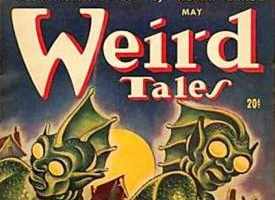
In addition to his own original fiction, Lovecraft took on work revising and ghostwriting the work of others; the most famous being stories written under the byline of the legendary magician and escape artist Harry Houdini; Weird Tales published the first, Imprisoned with the Pyramids, in 1924. Houdini was so impressed by Lovecraft’s story that he continued to offer Lovecraft other ghostwriting opportunities until Houdini’s death in 1926.
It is, in the main, due to the efforts of August Derleth and Donald Wandrei that ensured Lovecraft’s works would continue to be published. Derleth’s correspondence with Lovecraft began when Derleth was a teenager and, after HPL’s death, Derleth took some of Lovecraft’s incomplete works, finished them off, and then published them. Derleth co-founded with Wandrei the publishing company Arkham House, which played a key role in keeping Lovecraft’s work in print until it ultimately reached a wider audience.
It should be noted that Derleth’s work is controversial: while Lovecraft considered his alien beings as a mere plot device, Derleth created an entire cosmology of conflict between the Elder Gods and the Outer Gods (i.e. Cthulhu), what he termed the “Cthulhu Mythos,” and which had at its base a Christian world view, something entirely absent and anathema to Lovecraft. Even if one views this as an illegitimate child, the Cthulhu Mythos is a large part of Lovecraft’s continued presence in popular culture. There are at least four other publishing houses in addition to Arkham House devoted to printing Lovecraft’s fiction, letters, and essays, as well as fiction by other authors who utilize Lovecraftian themes. These include Hippocampus Press, Night Shade Books, Necronomicon Press, and the University of Tampa Press. Lovecraft’s fiction, ostensibly in the public realm, as well as much of non-fiction, can be found in digital form at the H. P. Lovecraft Archive website.
As Lovecraft became more widely known, he influenced a number of significant writers of our present age. In addition to those aforementioned authors who acknowledge Lovecraft’s influence on their work, the acclaimed Argentine writer Jorge Luis Borges wrote a short story, dedicated to the memory of Lovecraft, titled There Are More Things (Borges, 1975). When The Library of America published a volume of his fiction in 2005, it essentially declared that Lovecraft was a canonical American writer. The French novelist Michel Houellebecq wrote an excellent long essay on Lovecraft, called Lovecraft: Against the World, Against Life” (Houellebecq, 2005). Two French philosophers – Gilles Deleuze and Felix Guattari – in their work A Thousand Plateaus, claimed that Lovecraft’s short story Through the Gates of the Silver Key is a masterpiece (Deleuze & Guattari, 1993). S. T. Joshi, both a novelist and scholar, has perhaps done more than any other individual to cultivate the relevance and aesthetic worth of Lovecraft. He has written what is considered the definitive biography of Lovecraft, called I Am Providence: The Life and Times of H. P. Lovecraft (Joshi, 2010, 2 vols.). Joshi has also written numerous books on or about Lovecraft and his themes, edited five volumes of Lovecraft’s letters, and has collected in several volumes critical essays on Lovecraft and Lovecraft’s influence on other artists.
Lovecraft’s impact on popular culture extends deeply into other media and art forms. As Matthew Baldwin writes, “interest in Lovecraft and his “Cthulhu Mythos” has burgeoned in the last 30 years, with new books, films, games, graphic novels, and even albums based on the writer’s work released annually. And curiously, enthusiasm for a man who wrote of eldritch gods and antediluvian cults has found fertile ground in that pinnacle of modern technology, the internet” (Baldwin, 2012).
In the world of film, directors John Carpenter, Stuart Gordon, and Guillermo del Toro have all acknowledged Lovecraft’s influence. Toro has also expressed his desire to make a film of Lovecraft’s short novel At the Mountains of Madness; Toro had gone as far as writing an initial screenplay in collaboration with Matthew Robbins. Unfortunately, Universal Pictures put a hold on the production, but Toro remains stalwart. In a recent Wall Street Journal article, he said: “It’s certainly a possibility in the future. Legendary was very close to doing it at one point, so I know they love the screenplay. So, we’ll see. Hopefully it’ll happen. It’s certainly one of the movies I would love to do. … I think there’s a really strong possibility we can do it (“At the Mountains of Madness”) at Legendary because now they are at Universal, and Universal, you may remember, almost greenlit the movie. The fact that we now have two studios together that love the material, and if they support each other, they are risking a lot less. It would be great to do it, but I’ve understood that you don’t plan your career, it just happens” (Calia, 2014). Toro expects the budget to be $150 million.
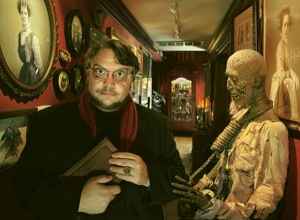
Lovecraft’s tentacles reach as well into the visual arts, where Jean “Moebius” Giraud, the noted French comic book artist, affirmed HPL’s influence. The artist H. R. Giger, best known for his design on the 1979 science-fiction/horror film Alien, was a self-acknowledged Lovecraftian, and stated that he liked the Alien storyline “because I found it was in the vein of Lovecraft, one of my greatest sources of inspiration” (Levy, 1979).
There have been a number of adaptations, successful and not so successful, of Lovecraft’s stories into film. The best of these were produced by the H. P. Lovecraft Historical Society. Their 2007 silent film adaptation of The Call of Cthulhu, shot in “mythoscope,” received excellent reviews. The H. P. Lovecraft Historical Society also released, in 2011, a black and white talking adaptation of The Whisperer in Darkness (also shot in“mythoscope”). The Innsmouth Free Press wrote that “The Whisperer in Darkness is a hell of a fine film, one of the best adaptations of a Lovecraft story ever made, and it’s far superior to the vast majority of bigger-budget films that have ‘H. P. Lovecraft’s’ before their titles” (Sammons, 2012).
Though not a complete list, films based on Lovecraft’s stories, or based on Lovecraft’s themes, would include: Roger Corman’s 1963 The Haunted Palace, based on The Case of Charles Dexter Ward; The Dunwich Horror released in 1970; and Rod Serling’s Night Gallery television series adapted two Lovecraft stories, “Pickman’s Model,” and “Cool Air.” As noted above, Ridley Scott’s 1979 movie Alien had a strong Lovecraftian presence, especially in the set design by H. R. Giger, who actually published an art book entitled Necronomicon, the fictional book Lovecraft alludes to in several stories. Sam Raimi’s Evil Dead franchise (1981, 1987, and 1992) all contain as plot elements the fictional Necronomicon. The 1985 movie Re-Animator, based on “Herbert West: Reanimator,” enjoys cult status, And in 2001, Stuart Gordon released Dagon, based on the HPL’s story The Shadow Over Innsmouth.
Lovecraft’s work has been a staple of board gaming for at least 30 years. In 1981, Chaosium published a horror role-playing game called Call of Cthulhu, which is currently in its seventh major edition. Chaosium also publishes long out of print classic weird tales, usually in some way Lovecraftian in subject matter. The H. P. Lovecraft Historical Society created the roleplaying game Cthulhu Lives in 1984, which is still going strong. Other board games include Arkham Horror, Eldritch Horror, and Elder Sign. In April of 2014, Cryptozoic Entertainment released The Doom That Came To Atlantic City, described as “A light-hearted game of urban destruction set in the universe of H.P. Lovecraft.”
Video games have also used Lovecraft’s work and themes either directly or as an influence. These include Call of Cthulhu: Dark Corners of the Earth; Quest for Glory IV: Shadows of Darkness; Alone in the Dark; Cthulhu Saves the World; Prisoner of Ice; and in the immensely popular MMORPG (Massive Multiplayer Online Role Playing Game) World of Warcraft, created in 2004, the names of the Old Gods and other character names are either taken from Lovecraft or influenced by his characters’ names. World of Warcraft is the world’s most subscribed MMORPG, with over 100 million accounts created over the game’s lifetime; it has grossed 10 billion dollars as of 2012.This is not an exhaustive list; there are many more video games, board games, and role-playing games that bear the stamp of Lovecraft’s influence.
Finally, one might try to determine HPL’s influence and popularity by determining just how much money is spent on Lovecraft’s books, movies, DVDs, comic books, board games, video games, apparel, conventions, etc. Unfortunately, this sort of detailed and parsed information is difficult to ascertain. The H. P. Lovecraft Historical Society conducted an online survey over ten months in 2001 – 2002. In addition to various demographic and marketing information from their target audience, they asked the survey takers to estimate how much money they spent on Lovecraft related items per year. The results are as follows:
| Less than $100 | 27% | $1,000 – $2,500 | 7% |
| $100 – $250 | 28% | $2,500 – $5,000 | 2% |
| $250 – $500 | 22$ | Over $5,000 | 1% |
| $500 – $1,000 | 11% | Other | 2% |
This is not in any way an objective or statistically sound sample – the 500 or so people who participated in this lengthy online survey were obviously all Lovecraft aficionados, predisposed to dispose of their income on Cthulhu and his ghastly minions. If we use the bottom figure in each category ($50 in the first category), and use 500 as the base, we see that an impressive $160,750 was spent, an average of $322 per person per year.
We can also look at the fundraising website Kickstarter, which has a surprisingly large number of Lovecraftian inspired projects up for donations. Some of these are fairly straightforward, things you might expect, although perhaps not the amount you might assume, while other projects simply verge on the sort of bizarreness found in HPL’s fiction. I’ll use three straightforward examples::
- The Chicago toy company Warpo intends to produce a “Legends of Cthulhu Retro Action Figure Toy Line.” As of July, 2014, they raised a startlingly $131,814 – their goal was $60,000.
- An annual Lovecraft Film Festival in Portland, Oregon (now in its 18th year) raised $16,944 for its 2013 Festival. For its 2014 Lovecraft Film Festival, it raised $31,720, just a bit under twice as much as in 2013.
- In 2013, the effort to raise money to build a life-sized bust of HPL, to be placed in the Athenaeum Library in Providence, surpassed its goal of $30,000 is several days, and closed by raising $58,023.
Now, the bizarre whose only appropriate response is humor. For those who have read Lovecraft, general descriptions of his stories would encompass words such as grim, bleak, desolate, utterly comfortless, always hopeless, dismal, with never a hero (all the protagonists either go mad or flee screaming), crushingly nihilistic, and so forth. Likewise, they are populated with an endless surge of grotesque, malformed, misshapen, hideous and evil beings, monstrous hybrids, or entities, or aliens, all far older than mankind, all treating humanity with either indifference or outright hostility.
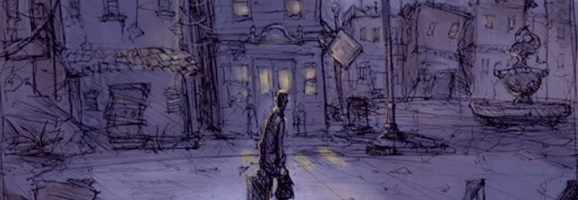
Here is Lovecraft’s description of the now iconic Cthulhu in the long story The Call of Cthulhu: “[Cthulhu is] a monster of vaguely anthropoid outline, but with an octopus-like head whose face was a mass of feelers…one of a race of vast, unknowable elder beings who lurk at the crossroads between dimensions, or sleep fitfully in underwater cities, waiting until the time is right to rise again and devour all life on the planet” (Lovecraft, 1928).
This is not a story you would read to your six year-old at bedtime. It is probably not a story you would read yourself before bedtime. Nevertheless, the Hendersons of Somerville, MA will be producing a book called: Baby’s First Mythos: Learning with Lovecraft. This “will be a complete artistic overhaul of the popular Lovecraftian children’s book.” The original taught to our youngsters the ABC’s and numbers using the Cthulhu mythos. Seems the children need a – what? – more Lovecraftian view of education now that we’re well into the 21st century? I simply can’t think of a better way to teach our children letters and numbers than by scaring the holy bejesus out of them. Their stated goal: $10,000. The final amount raised: $24,852.
In the same unearthly vein, a Mr. Rex and Ms. Bella want to print Littlest Lovecraft: The Dunwich Horror, an “illustrated, rhyming adaptation of H. P. Lovecraft’s The Dunwich Horror.”
For those of you who need an update, “Outsiders visit Dunwich as seldom as possible, and since a certain season of horror all the signboards pointing toward it have been taken down” (Lovecraft, 1929). Sounds like just the place for a family vacation. The creators want “to help grow a new generation of Lovecraftians by luring them in with our version of the story and tempting them to read the originals!” This “luring them in” sounds sinister in its own right. And lure them to what? Madness? Screaming hysteria? Night terrors the likes of which we could never imagine? Or, as Lovecraft’s story ends, “Without warning came those deep, cracked, raucous vocal sounds which will never leave the memory of the stricken group who heard them.” I’m all for teaching children that life comes with its downs as with its ups, but – The Dunwich Horror? As my children often say: seriously? Their goal for the project: $10,000. The amount raised: $35,792. Almost $36,000 dollars so that we can lure our children into reading the true account of the vile, blasphemous reality of the world.
Finally, and I’m just not sure what to make of this, the film company Midnight Crew Studios in Baltimore would like to produce Call Girl of Cthulhu, where a “virginal artist falls in love with a call girl who turns out to be the chosen bride of the alien god Cthulhu.” Okay, I’ve been in that situation before and, sure, I’ve thought at the time it would make a great movie, but that’s about as far as I’ve taken it. They need $25,000. They raised $27,750.
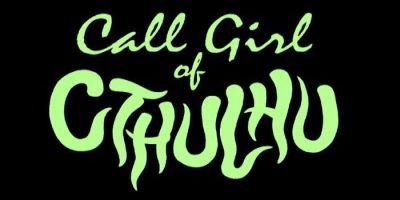
These are just a sampling of some of the sane (in Lovecraft’s world) and not so sane (in our world) projects – there are over 20 Lovecraftian Kickstarters up there now, most with more modest goals and amounts raised, but almost all have either reached or exceeded their aim.
While the evidence I’ve supplied is admittedly anecdotal, and nowhere near as precise as I’d wish, it does at the least indicate how Lovecraft has become an increasingly popular force in American popular culture, from the Library of America’s imprimatur to the various odd children’s books with Lovecraftian characters, from Cthulhu plush toys to annual HPL film festivals.
Why Lovecraft Now?
Why this upsurge in all things Lovecraftian over the last thirty years? What is the allure, the enchantment, the fascination of this atheistic though puritanical author from New England, a teller of tales saturated with grim foreboding, pervasive dread, and wholesale apprehension?
Several more or less cogent reasons have been given for HPL’s popularity, most notably from writers who also explore the regions of the macabre. Stephen King attributes Lovecraft’s influence to his ability to tap into our collective fears: “HPL continues to remain not just popular with generation after generation of maturing readers but viscerally important to an imaginative core group that goes on to write that generation’s fantasy and weird tales…and, by so doing, to chart that generation’s deepest fears” (King, 2008).
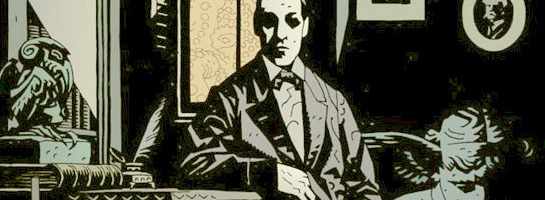
Michael Dirda, in a review of The Library of America’s volume of Lovecraft’s tales, surmises that “what makes Lovecraft so overwhelming to sympathetic readers isn’t his sometimes overheated prose–any more than the Grand Guignol of his plots (revival of the dead, the swapping of minds, aliens among us) or his philosophy of “cosmicism,” which reduces mankind’s role in the universe to a bit part, hardly even a walk-on. What matters is that he possesses the storyteller’s greatest gift, the one Nabokov called shamanstvo: the “enchanter quality.” This narrative sorcery derives, to a great extent, from Lovecraft’s mastery of atmosphere–created by the very prose for which he is mocked” (Dirda, 2005).
S.T. Joshi reasons thus: “Lovecraft didn’t get bogged down in the minutiae of the daily life of his characters. The people in his stories face ‘big’ issues of identity, humanity’s place in the universe, and the psychological effects of knowledge in ways that are not tied to the time period in which the stories written, so that they can speak across the generations” (Baldwin, 2012).
Dr. Amy Sturgis, in an article entitled “The New Shoggoth Chic: Why H. P. Lovecraft Now?” ascribes his relevance by reference to the tension felt by individuals between hope and despair: “As the 21st century unfolds as a time of rapid innovation, vast change, cultural conflict, violent warfare, and natural disasters, it is not difficult to see why these questions might be at the forefront of many readers’ minds. It may be the case that the tension between logic and faith, despair and hope is the truest reflection of the audience today, an accurate depiction of the uncertainty of our era” (Sturgis, 2005).
Neil Gaiman, author of the Sandman graphic novels, as well as award-winning novels and short stories, wrote an introduction to a collection of Lovecraft stories centered on dreams (Dreams of Terror and Death). The nature of his answer to the question of why Lovecraft now is one of refreshing puzzlement: “So what is it about Lovecraft that keeps me coming back? That keeps any of us coming back? I don’t know. Maybe it’s jus that we like the way he gives us monsters to draw with our minds. If this is your first excursion into H. P. Lovecraft’s world, you may find the way a little bumpy at first. But keep going. You’ll soon find yourself driving down a road that will take you through the Twin Cities [fantasy & horror], and off into the darkness beyond. If Literature’s the world. And it is” (Gaiman, 1995).
The novelist Joyce Carol Oates, who edited a collection of Lovecraft’s stories in the late 1990s, points to Lovecraft’s ability to invoke an atmosphere of dread, a climate of vague terror ancillary to the plot of the story. “Lovecraft’s most effective tales are those in which atmosphere is predominant and plot subordinate; in which a richly detailed, layered narrative circles about a numinous, indefinable image…There is a melancholy, operatic grandeur in Lovecraft’s most passionate work…a curious elegiac poetry of unspeakable loss, of adolescent despair, and an existential loneliness so pervasive that it lingers in the reader’s memory, like a dream, long after the rudiments of Lovecraftian plot have faded” (Oates, 1996).
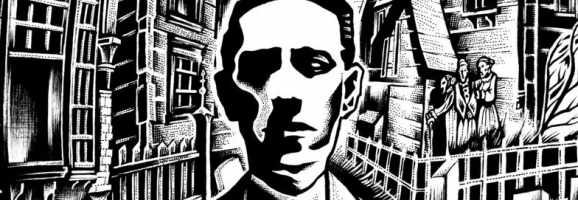
Finally, the French author Michel Houellebecq, in his long and exceptional essay entitled H. P. Lovecraft: Against the World, Against Life, offers a somewhat more poetic as well as precise ground for the increasingly pertinent influence of HPL:
“Horror writers are reactionaries in general simply because they are particularly, one might even say professionally, aware of the existence of Evil. It is somewhat curious that among Lovecraft’s numerous disciples none has been struck by this simple fact: the evolution of the modern world has made Lovecraftian phobias ever more present, ever more alive…This is the profound secret of Lovecraft’s genius, and the pure source of his poetry: he succeeded in transforming his aversion for life into an effective hostility…To offer an alternative to life in all its forms constitutes a permanent opposition, a permanent recourse to life – the is the poet’s highest mission on the earth. Howard Philips Lovecraft fulfilled this mission” (Houellebecq, 2005, p. 117, 119).
All of these reasons – and there are others, though they are often vague, are forms of explanation that do not actually explain – undoubtedly express some facet of Lovecraft’s popularity, which is also, undoubtedly, complex.
Specifically, the argument that as the modern world has evolved, Lovecraft’s vision of modernity becomes ever more relevant to the forces, movements, and conditions that assail individuals and social groups carries a singular force. Various authors have noted that several themes run throughout Lovecraft’s fiction. These include the theme of the denied primacy of the human race; that there is, or should be, forbidden knowledge, coupled with the notion that certain ignorance is merciful; the theme that surface appearances are not as they seem, including the idea that the distinction between reality and dreaming is ambiguous at best, simply false at worst; and the theme of unwholesome survival (Burleson, 1991).
But as China Miéville points out in his astute “Introduction” to At the Mountains of Madness, the themes of the ongoing and inevitable decadence of the West, a decadence inculpated by modern scientific knowledge, capitalism, and the horror of World War I, occupies a privileged position not only in Lovecraft’s story but throughout the body of his writings (Miéville, 2005).
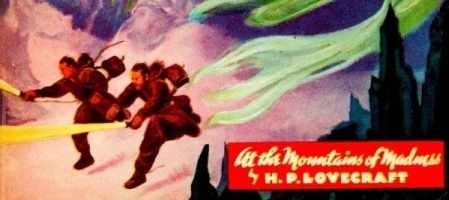
In Part 2 of this essay, I will turn to the questions raised in Lovecraft’s work about the nature of science, scientific knowledge, technology, and decadence in Western civilization – as an account of these themes offers a more comprehensive and robust demonstration for Lovecraft’s relevance and currency in American popular culture.
Works Cited
Baldwin, Matthew (2012). H. P. Lovecraft, Author, Is Dead. Retrieved on June 29, 2014 at: http://www.themorningnews.org/article/h.p.-lovecraft-author-is-dead.
Borges, Jorge Luis (1998). “There Are More Things,” in Collected Fictions. Translated by Andrew Hurley. New York: Viking.
Brown, Maggie (2013). Weird Tales: “slick-paper fiction wrapped in pulp.” Colloquium Magazine. Accessed August 7, 2014 at: http://lucian.uchicago.edu/blogs/colloquium/2013/06/05/weird-tales-slick-paper-fiction-wrapped-in-pulp/.
Calia, Michael (2014). “Guillermo del Toro on ‘Pacific Rim 2,’ ‘At the Mountains of Madness’ and More,” The Wall Street Journal, July 3, 2014. Accessed August 12, 2014 at: http://blogs.wsj.com/speakeasy/2014/07/03/guillermo-del-toro-on-pacific-rim-2-at-the-mountains-of-madness-and-more/?KEYWORDS=del+toro.
Camp, L. Sprague de (1975). Lovecraft: A Biography. New York: Doubleday.
Davenport-Hines, Richard (1998). Gothic: Four Hundred Years of Excess, Horror, Evil, and Ruin. New York: Farrar, Straus and Giroux.
Deleuze, Gilles & Guattari, Félix (1993). A Thousand Plateaus. Translated by Brian Massumi. Minneapolis: University of Minnesota Press, p. 240, 539.
Dirda, Michael (2005). “The Horror, the Horror! H.P. Lovecraft enters the American canon,” The Weekly Standard, Vol. 10, No. 23.
Gaiman, Neil (1995). “Introduction: Concerning Dreams and Nightmares,” in Dreams of Terror and Death, H. P. Lovecraft. New York: The Random House Publishing Group.
Houellebecq, Michel (2005). H. P. Lovecraft: Against the World, Against Life. Translated from the French by Dorna Khazeni. Great Britain: Orion Publishing Group.
Joshi, S. T. (2010). I Am Providence: The Life and Times of H. P. Lovecraft. New York: Hippocampus Press.
King, Stephen (2008). “Introduction” to H. P. Lovecraft: Against the World, Against Life, by Michel Houellebecq. Great Britain: Orion Publishing Group.
Levy, Frederic Albert (1979). “H. R. Giger – Alien Design” in Cinefantastique, 1979, Vol. 9, Issue 1, pp. 35-39. Retrieved from littlegiger.com on June 21, 2014.
Lovecraft, H. P. (1915). “The Crime of the Century,” in The Conservative, 1.
Lovecraft, H. P. (1918). “At the Root,” in The United Amateur, 17, No. 6, pp. 111-12.
Lovecraft, H. P. (1927). “Supernatural Horror in Literature,” The Recluse, No. 1, pp. 23-59.
Lovecraft, H. P. (1928). “Call of Cthulhu,” Weird Tales, 11, No. 2, pp. 159-78.
Lovecraft, H. P. (1929). “The Dunwich Horror,” Weird Tales, 13, No. 4, pp. 481-508.
Lovecraft, H. P. (1937). “The Thing on the Doorstep,” Weird Tales, 29, No. 1, pp. 52-70.
Miéville, China (2005). “Introduction” to At the Mountains of Madness: The Definitive Edition. New York: The Modern Library.
Oates, Joyce Carol (1996). “The King of Weird,” The New York Review of Books.
Sammons, Brian (2012). “Cthulhu Eats the Movies: The Whisperer in the Darkness,” Innsmouth Free Press, accessed August 15, 2014 at: http://www.innsmouthfreepress.com/blog/column-cthulhu-eats-the-movies-the-whisperer-in-darkness-2011/
Siclen, Bill Van (2013). “Festival to Draw Fans of Horror Legend H. P. Lovecraft To His Home Turf,” Providence Journal, August 18, 2013. Retrieved on June 29, 2014 from: http://www.providencejournal.com/features/entertainment/books/20130818-festival-to-draw-fans-of-horror-legend-h.p.-lovecraft-to-his-home-turf.ece.
Spengler, Oswald (1931). Man and Technics: A Contribution to a Philosophy of Life, translated from the German by Charles Francis Atkinson, New York: Alfred A. Knopf, 1932. Originally Der Mensch und Die Technik, Munich: C.H. Beck Verlagsbuchhandlung.
Sturgis, Amy H. (2005). “The New Shoggoth Chic: Why H. P. Lovecraft Now?” in Apex Science Fiction and Horror Digest, Vol. 1, 4.
Toro, Guillermo del (2001). “Haunted Castles, Dark Mirrors: On the Penguin Horror Series,” in The Thing on the Doorstep and Other Weird Stories, by H. P. Lovecraft. New York: Penguin Books.
Wohleber, Curt (1995). The Man Who Can Scare Stephen King. December 1995, Volume 46, Issue 8. Accessed June 29, 2014 at http://www.americanheritage.com/content/man-who-can-scare-stephen-king.
What do you think? Leave a comment.











He uses big words! and the writing style is a little dry at points but Lovecraft is a master story teller, the things he comes up with are amazing.
Must read for horror fans.
I have never met a soul who did not…appreciate…the genius of Lovecraft’s historical works.
Looking forward to reading next one. He is a master of macabre, bizarre stories and influence to countless many.
Sadly I’ve realized that his settings were more interesting than his writing.
Would love to see a compilation of great contemporary writers that put together
Lovecraftian short stories.
The stories are so rich and the language so byzantine that I have to take time between them to digest.
Many of the comments thus far concern Lovecraft’s style as a writer, and this is something I should have addressed in the article. So thanks for bringing it up. As Bruce and Chun note, Lovecraft writes in a “Victorian” style, or more generally in a 19th century style. His sentences can be long and convoluted, and he never met an adjective he didn’t like.
With that said, I actually think that the way Lovecraft wrote was a conscious decision, and one tied intimately to the aim of producing in the reader cosmic dread, disorientation, and fear because “fear of the unknown is our deepest and strongest emotion.” If folks want to dismiss Lovecraft because he is a pulp writer, this would entail the condition that all writing about monsters and such is also only pulp. This is a contingent cultural judgment. Within the genre of “weird tales,” there can be good writing and bad writing, just as we find well written tragedies and badly written tragedies.
I think Lovecraft chose the style that he did because it produced those emotions he was attempting to provoke in the reader, and because the style also let him explore the philosophic ideas at the heart of his stories. Lovecraft wrote several essays on the craft of writing, and the one that is pertinent here is called “Notes on Writing Weird Fiction,” published in 1937. This is what he has to say about how and why he writes in the way that he does:
“In writing a weird story I always try very carefully to achieve the right mood and atmosphere, and place the emphasis where it belongs. One cannot, except in immature pulp charlatan–fiction, present an account of impossible, improbable, or inconceivable phenomena as a commonplace narrative of objective acts and conventional emotions.”
“Being the principal thing in the story, its mere existence should overshadow the characters and events. But the characters and events must be consistent and natural except where they touch the single marvel. Never have a wonder taken for granted. Even when the characters are supposed to be accustomed to the wonder I try to weave an air of awe and impressiveness corresponding to what the reader should feel.”
“Atmosphere, not action, is the great desideratum of weird fiction. Indeed, all that a wonder story can ever be is a vivid picture of a certain type of human mood. The moment it tries to be anything else it becomes cheap, puerile, and unconvincing. Prime emphasis should be given to subtle suggestion—imperceptible hints and touches of selective associative detail which express shadings of moods and build up a vague illusion of the strange reality of the unreal.”
So there it is. Whether Lovecraft fails or succeeds in his attempt to produce in the reader an emotion or feeling is really the question. The question should not be, in my view, is Lovecraft’s style archaic and arcane. Apologies for not addressing this in the essay itself and thanks to all for bringing it up in your comments.
Not a huge fan of the style of writing but I am a fan of the stories, 100 years ago this would have been an excellent read for me, but I would like more these days.
I could read ‘The Call Of Cthulhu’ over and over. I love the way the story is told. Pieced together, out of order like a real investigation into a cult. With an ending that just chills you.
If Nietzsche would have written novels, they would have read exactly like H.P. Lovecraft. Lovecraft’s nihilism makes for fascinating storylines and great themes, particularly when he is comparing scientific curiosity with peasant superstition.
H.P. sure as hell doesn’t know how to start a story, often meandering around for two pages before he gets going.
Victorian-era psychological horror at it’s best. Just don’t get too attached to any of the characters though!
Outstanding article. This guy knows how to write horror. Not the cheap gore-fest type, but the psychological kind that sticks with you for some time. He’s got mind-blowingly ancient civilisations, eldritch cults, and menacing aliens down to an art, baby.
It is quite likely that these tales seem silly to our modern way of thinking, although, in his day they would have been the equivalent of watching the ‘Aliens’ film with you hands tied behind your back and your eyes glued wide open….
Call me a cretin, but I’m just not getting the appeal of Lovecraft.
Cretin.
The Colour Out of Space is my favorite.
I have always like Poe, and I do not know why I never graduated to Lovecraft. He’s a writer from the 1920s and 30s who was ahead of his time as far as psychological horror goes. None of his stuff is really scary by today’s definition, but even still, it gives you a chill.
Enjoy learning more about the ancient cultures that he creates. “The Rats in the Walls” gives me goosebumps just thinking about it and has aged well as a superbly crafted horror tale.
I certainly appreciate how Lovecraft is such an influential horror author. His line of work is almost philosophical and at its best makes one think of Borges. But it is also full of racism, bitterness and shows a lack of humanity that makes it seem impenetrable.
Bridgett, you are absolutely right about Lovecraft’s racism – it is sort of the rhinoceros in the room that nobody wants to say is there (including myself). But there is no doubt that he despised Jews, Blacks, and any other ethnic group that did not derive from Anglo-Saxon stock. Most of the worst is in his letters, but also shows up in several stories, especially “The Shadow Over Innsmouth.” In this story, the horror lies in the mixing of the race of the residents of Innsmouth with the creatures that live in the sea, off of Devil’s Reef. It is miscegenation that horrifies Lovecraft – and in the story, these hybrids are described as “…surging inhumanly through the spectral moonlight in a grotesque, malignant saraband of fantastic nightmare…Their forms vaguely suggested the anthropoid, while their heads were the heads of fish, with prodigious bulging eyes that never closed.” Lovecraft had a hysterical fear of miscegenation and the product of his paranoia in his stories are these monstrous beings, half-human, half-fish.
I think about the best that can be said concerning Lovecraft’s overt racism is what China Miéville wrote in his Introduction to “At the Mountains of Madness”: “Happily, there is no contradiction between despising a writer’s politics and admiring the very art they helped create…The very race-inflected nihilism we vigorously repudiate is simultaneously a central engine for what we admire in Lovecraft’s art.”
I know this is an older comment. But, I don’t think most people are ignoring Lovercrafts or any authors racism/questionable past. (At least I’m not.) I think most people who love art for arts sake understand that some individuals are going to have ideas that they don’t agree with. That some individuals out there have done horrible things. I understand if some people can’t turn a blind eye to it. And in that case I think they shouldn’t support Lovecraft or any artist who offends them on such a level. But, if you’re going to read,watch or explore someone else’s art your going to have accept that they have different ideas. It doesn’t mean you, yourself are complicate in their action or enable them to behave in such away. Everyone is ultimately responsible for their own actions and beliefs. No one can change that. I also believe you can appreciate the artistic talents of someone, while not endorsing the personal choices of an artist. For me I love many of the games created by Hideki Kamiya, but I don’t think me and the guy would get along in real life.
Many horror writers owe Mr. Lovecraft quite the debt let me tell you. If only the poor guy had received any sort of respect or recognition when he’d been alive.
I can easily see how his writing has influenced contemporary horror writers.
I specifically like how he writes in first person, and how his narrators struggle to describe the horrors they are seeing.
Lovecraft’s pieces revolves around one main idea. If man knew the truth, of what is really out there, man can only respond in two ways: death and/or insanity.
So very much more than fairly badly written pulp tales. A view of the universe and man’s place in it that was utterly prescient for its day.
I love Lovecraft’s “The Colour Out of Space.” Great article and I can’t wait for part 2!
I consider most of the work very predictable. Also, it bothered me that he rarely uses dialogue. Kind of makes all the characters seem flat.
CDK has done excellent work in elaborating on H.P. Lovecraft’s work, mood, and philosophy, which of no doubt, was armored by his experiences of acknowledging the history of World War I. A dark era for many people, Lovecraft was influenced and sought to shade his mythopoeia with the darkness that enshrouded them, thereby demonstrating that no a single person covered by the darkness of warfare was safe. A classical technique? Or a philosophical overture? Whatever, his cosmicism evolved from it!
Fantastic article. Can’t wait to read part two. When I saw Pan’s Labyrinth and read about del Toro’s work, I absolutely noticed Lovecraft’s fingerprints. Lovecraft utilizes terror of the unknown amazingly well, and his themes aligned so well with the modern horrors of war and the pervasive disillusionment.
HPLs stories are mainly about creating the environment of impending doom. An utter feeling of paralysis sometimes. You know the Horror is just around the corner, outside the window…just…well…just waiting